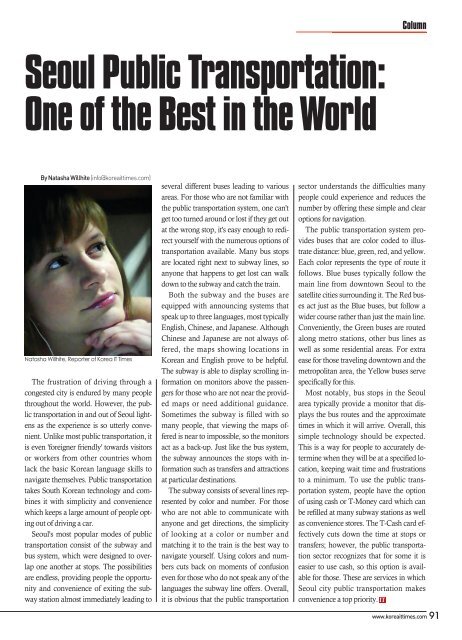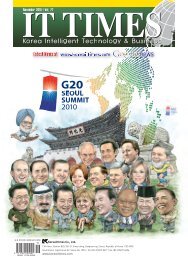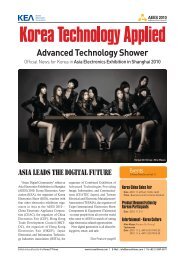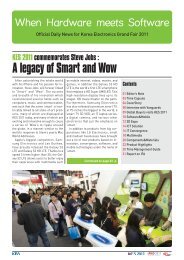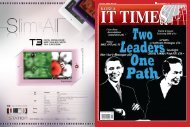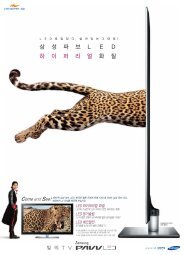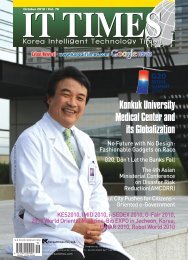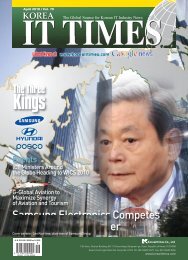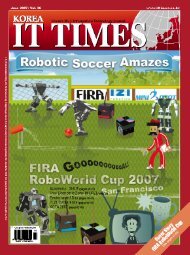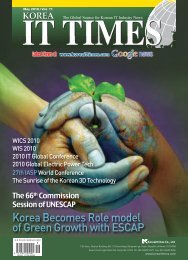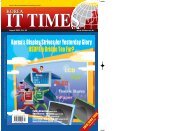You also want an ePaper? Increase the reach of your titles
YUMPU automatically turns print PDFs into web optimized ePapers that Google loves.
Column<br />
Seoul Public Transportation:<br />
One of the Best in the World<br />
By NatashaWillhite(info@koreaittimes.com)<br />
Natasha Willhite, Reporter of <strong>Korea</strong> <strong>IT</strong> <strong>Times</strong><br />
The frustration of driving through a<br />
congested city is endured by many people<br />
throughout the world. However, the public<br />
transportation in and out of Seoul lightens<br />
as the experience is so utterly convenient.<br />
Unlike most public transportation, it<br />
is even 'foreigner friendly' towards visitors<br />
or workers from other countries whom<br />
lack the basic <strong>Korea</strong>n language skills to<br />
navigate themselves. Public transportation<br />
takes South <strong>Korea</strong>n technology and combines<br />
it with simplicity and convenience<br />
which keeps a large amount of people opting<br />
out of driving a car.<br />
Seoul's most popular modes of public<br />
transportation consist of the subway and<br />
bus system, which were designed to overlap<br />
one another at stops. The possibilities<br />
are endless, providing people the opportunity<br />
and convenience of exiting the subway<br />
station almost immediately leading to<br />
several different buses leading to various<br />
areas. For those who are not familiar with<br />
the public transportation system, one can't<br />
get too turned around or lost if they get out<br />
at the wrong stop, it's easy enough to redirect<br />
yourself with the numerous options of<br />
transportation available. Many bus stops<br />
are located right next to subway lines, so<br />
anyone that happens to get lost can walk<br />
down to the subway and catch the train.<br />
Both the subway and the buses are<br />
equipped with announcing systems that<br />
speak up to three languages, most typically<br />
English, Chinese, and Japanese. Although<br />
Chinese and Japanese are not always offered,<br />
the maps showing locations in<br />
<strong>Korea</strong>n and English prove to be helpful.<br />
The subway is able to display scrolling information<br />
on monitors above the passengers<br />
for those who are not near the provided<br />
maps or need additional guidance.<br />
Sometimes the subway is filled with so<br />
many people, that viewing the maps offered<br />
is near to impossible, so the monitors<br />
act as a back-up. Just like the bus system,<br />
the subway announces the stops with information<br />
such as transfers and attractions<br />
at particular destinations.<br />
The subway consists of several lines represented<br />
by color and number. For those<br />
who are not able to communicate with<br />
anyone and get directions, the simplicity<br />
of looking at a color or number and<br />
matching it to the train is the best way to<br />
navigate yourself. Using colors and numbers<br />
cuts back on moments of confusion<br />
even for those who do not speak any of the<br />
languages the subway line offers. Overall,<br />
it is obvious that the public transportation<br />
sector understands the difficulties many<br />
people could experience and reduces the<br />
number by offering these simple and clear<br />
options for navigation.<br />
The public transportation system provides<br />
buses that are color coded to illustrate<br />
distance: blue, green, red, and yellow.<br />
Each color represents the type of route it<br />
follows. Blue buses typically follow the<br />
main line from downtown Seoul to the<br />
satellite cities surrounding it. The Red buses<br />
act just as the Blue buses, but follow a<br />
wider course rather than just the main line.<br />
Conveniently, the Green buses are routed<br />
along metro stations, other bus lines as<br />
well as some residential areas. For extra<br />
ease for those traveling downtown and the<br />
metropolitan area, the Yellow buses serve<br />
specifically for this.<br />
Most notably, bus stops in the Seoul<br />
area typically provide a monitor that displays<br />
the bus routes and the approximate<br />
times in which it will arrive. Overall, this<br />
simple technology should be expected.<br />
This is a way for people to accurately determine<br />
when they will be at a specified location,<br />
keeping wait time and frustrations<br />
to a minimum. To use the public transportation<br />
system, people have the option<br />
of using cash or T-Money card which can<br />
be refilled at many subway stations as well<br />
as convenience stores. The T-Cash card effectively<br />
cuts down the time at stops or<br />
transfers; however, the public transportation<br />
sector recognizes that for some it is<br />
easier to use cash, so this option is available<br />
for those. These are services in which<br />
Seoul city public transportation makes<br />
convenience a top priority.<br />
www.koreaittimes.com 91


